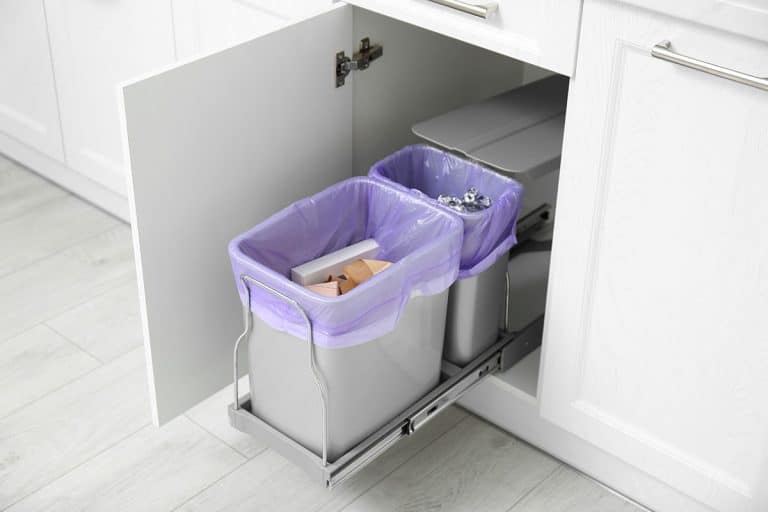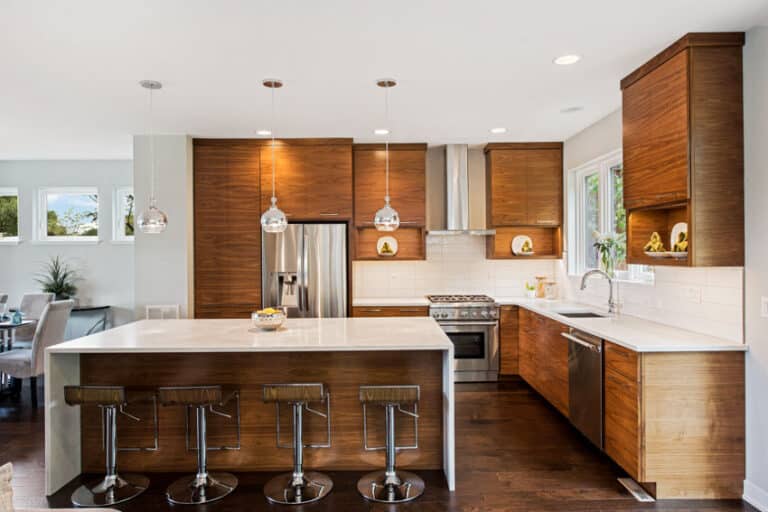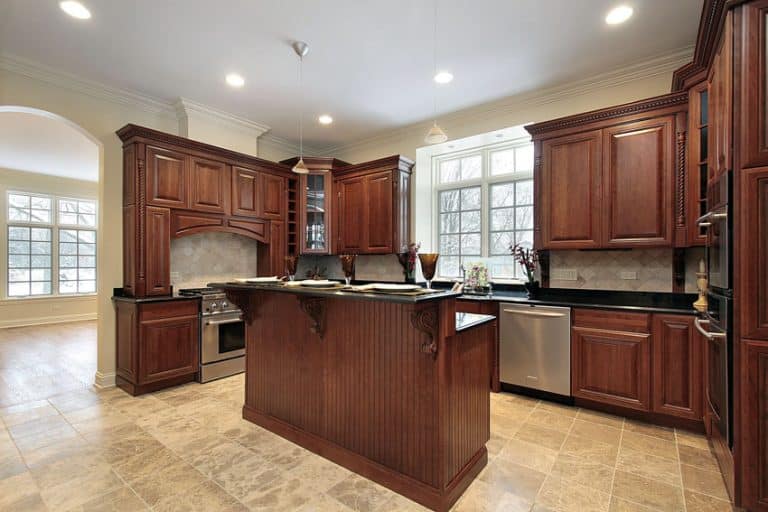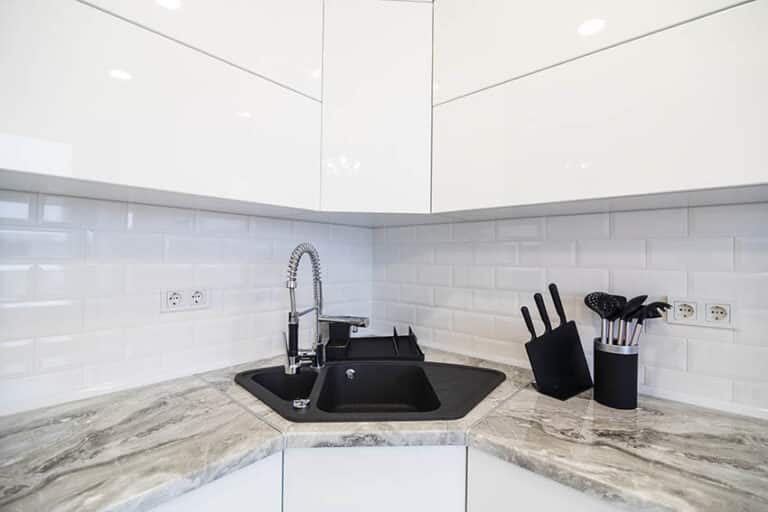Shaker Cabinets vs Raised Panel (Pros & Cons)
To create the kitchen of your dreams, one of the first things that you have to decide on is the style of cabinet that you will be using. Cabinets are undoubtedly the most dominant design feature in a kitchen. They take up most of the space and not only offer function but also contribute to visual aesthetics. Below, we take a look at two of the most popular cabinet styles — Shaker and raised panel cabinets.
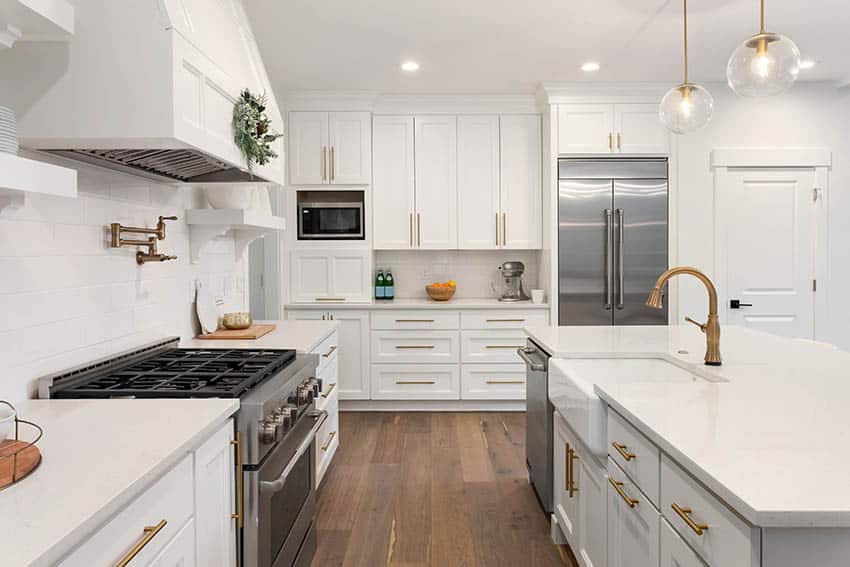
Both options are equally stunning, but this comprehensive guide will take you through their differences, their unique features and the practical benefits that they offer. Keep on reading so we can help you decide which one is best for your home.
What Are Shaker vs Raised Cabinets

Kitchen cabinet doors are generally classified into three types of door styles namely (1) slab or flat panel, (2) raised panel, and (3) recessed panel, sometimes referred to as Shaker cabinets. Each of these styles brings in a unique character to a kitchen which can help achieve the design inspiration or period style that you envision.
Here is a detailed look at the differences between raised panel cabinets and Shaker door styles:
What are Shaker Style Cabinets?
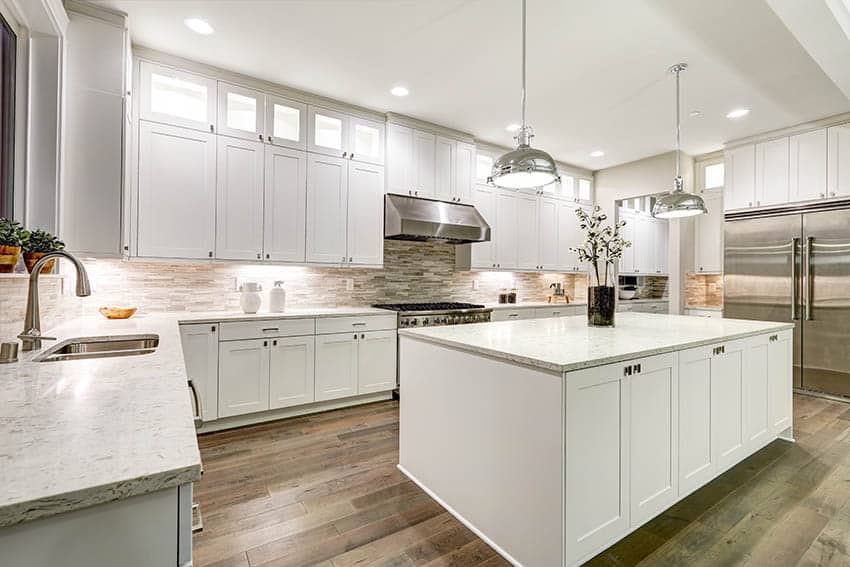
Shaker style cabinet doors are a type of recessed panel cabinet doors, characterized by a simple raised frame design. The center panel is lower, or recessed from the surrounding frame of the cabinet door.
The Shaker style was first introduced during the 1700’s by a group of exceptionally skilled craftsmen, but it reached its popularity during the 1930’s where it can be found in most homes.
Until now, this style has been one of the most prominent in kitchen design. Several modernist furniture designers have drawn inspiration from its simple yet timeless aesthetic.
What Features Define the Shaker Style?
The Shaker style is best known for its polished, well crafted woodwork which leans toward the austere and utilitarian. Aside from functionality, there are several other characteristics that define it.
Typically, cabinetry in this style uses the best quality hardwood available, such as oak, birch, maple, pine, chestnut, cherry, hickory, or ash.

The design of these cabinets is very simple — it has no ornamentation and is characterized by prominent straight lines, squared edges, and moderate proportions. Construction-wise, cabinets or drawers in this style are typically composed of five pieces — front with flat, recessed panels.
The most common finishing material used is wood stain, often in a light color, to enhance the natural tone of the hardwood used. To stay true to its simplicity, even the hardware, handles, and knobs used are very basic and lack flair.
What is a Raised Panel?
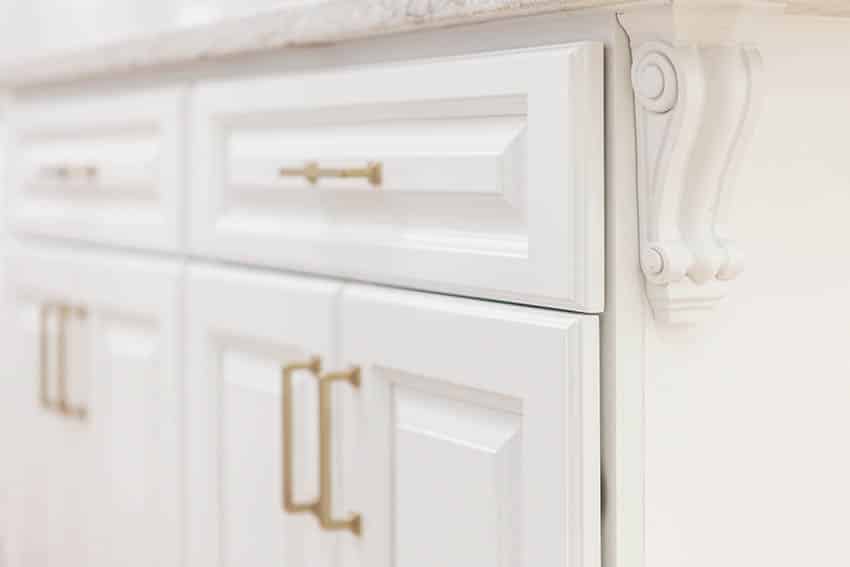
As its name suggests, a raised panel cabinet has a center panel that is slightly raised or higher than the surrounding wood or the main surface of the door. Raised panel cabinetry rose to popularity during the American colonial era when their presence in a home was a sign of wealth because they were more costly to make.
Construction-wise, raised panel cabinet doors are built by attaching the panel using an adhesive or by carving grooves into the cabinet door’s frame to create an outer rim or overlay.
The center panel may also be carved in such a manner that it slopes backward to the edges to create an elevated effect. This makes the cabinet door look as though it were carved out of a single, large plank.
The raised panel provides additional depth and dimension to a simple flat panel door design. Raised panel cabinets come in a variety of styles and designs, which allow them to fit into both traditional and modern kitchen settings.
What are the Features of a Raised Panel Cabinet?
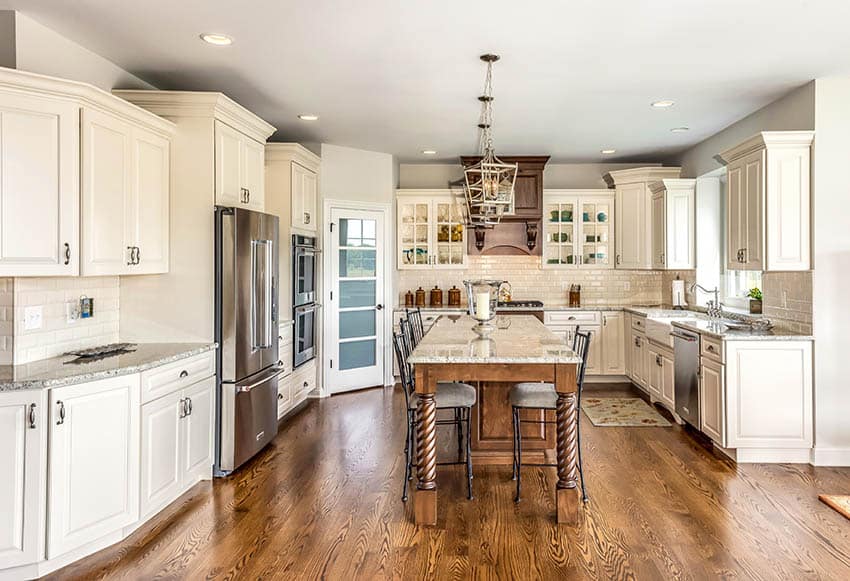
As we have mentioned, raised panel doors come in a variety of designs and the trim work they feature may not always be the same. The overlay around the center panel is generally grooved, but in some cases, they have a decorative edge on the interior and exterior. Aside from grooves, beveling and beading can also be incorporated into the design to achieve a more decorative effect.

The most common design comes with a simple framework around the edges, while some variations include a stepped frame to add more visual depth and dimension to the door. Other raised panel doors feature arches instead of square edges. Some designs may also incorporate a combination of different raised center panels and framed-type panels
Unlike Shaker cabinets which are typically made of solid wood through and through, raised panel doors can be constructed using mixed materials. Glass or metal inserts may be used to add more ornamentation to the original wooden raised panel door design.
Differences Between Shaker And Raised Panels
The Shaker style and raised panel style add a unique character to a kitchen, and each option presents different advantages and disadvantages. Below, we have outlined the differences between the two based on several qualities and factors:
Appearance – The biggest and most noticeable difference between shaker-style and raised panel cabinets is their appearance.
As mentioned earlier, Shaker panels have a flat, recessed center panel while raised panels have a central panel that is slightly higher than the outer frame.
Raised panels also have a more three-dimensional appearance compared to Shaker-style cabinets.
Overall, Shaker-style cabinetry has a much more simple design as both the center panel and the outer frame of the door are completely plain.
Meanwhile, with raised panels, the edges surrounding the center panel may be grooved, carved, or laid with some type of decorative detail.
Style. Because of the simplicity and minimalist aesthetic of Shaker-style cabinetry, they tend to be more contemporary and are often used in transitional, rustic, and modern kitchen designs.
On the other hand, raised panels are predominantly used in traditional kitchen interiors due to their formal design. See more rustic kitchen cabinet designs on this page.
Installation. Raised panels and Shaker style refer to both the door style of the cabinet and the drawer front. They do not refer to the kitchen cabinetry as a whole, which means that regardless of the door style used, the difficulty, method, and cost of installation will vary depending on the overall design and layout of the cabinetry.
Both types of door styles come in framed or frameless construction with full overlays or semi-overlays. If both of them are constructed the same way, then installation will also be the same for both.
Framed or Frameless Construction. There are two ways to manufacture kitchen cabinets, namely frameless and framed construction.
Framed cabinetry is the traditional way cabinet manufacturers use. In this method, the door is attached to a 1-½ inch frame.
The frame somewhat resembles a picture frame and adds dimension to the door front. Framed construction gives cabinetry more strength and adds sturdiness since the doors are well secured to a supporting frame. This type of construction also allows for more flexibility and customization in terms of design.
On the other hand, frameless cabinetry eliminates the use of a face frame, and just the cabinet box or carcase remains. This method is the European way of manufacturing cabinetry and can be typically found in more contemporary and modern designs.
Frameless construction relies on a thicker cabinet carcase for more strength and stability. Since the doors are directly attached to the sides of the cabinet, the result is a cleaner look. With frameless construction, the stiles between two cabinet doors are also removed, allowing more “full access.”
Shaker and raised panels can be found in both framed and frameless types of construction. However, raised panels can be more difficult to find in frameless construction because of its traditional style. Shaker, on the other hand, usually uses frameless construction because of their sleeker and more contemporary design.
Availability. Whether prefabricated or custom made, both types of cabinet styles are readily and widely available in the market. Shaker and raised panels are both very popular and a majority of manufacturers have them in stock or offer them as special order.
However, if you prefer frameless cabinets, you may find that Shaker style cabinet doors are more widely available in this type of construction. The reason is that most frameless cabinet makers make more contemporary kitchen cabinets or modern styles.
Maintenance. The door style of a kitchen cabinet does not affect the maintenance it requires. Rather than the design, this aspect is more dependent on the type of material and finishing used. So regardless if it is Shaker style or raised panel, the maintenance will be the same.
Both types of cabinet door styles tend to collect dust and other types of dirt along the edge of the panel or the outer frames. The bigger the overlay, the more noticeable the dirt is.
But then again, regardless of the door style, both need to be wiped and cleaned regularly to ensure that they stay in their top quality and appearance.
Resale Value. The style of cabinet door used in a kitchen won’t have much impact on the value of a home. Other design factors in kitchen cabinetry can add value to a home’s resale value, like the type of materials and finishing used.
Solid materials such as quality hardwood, and soft close hardware are some examples of factors that appeal most to potential buyers.
If you want to increase the resale value of your home using Shaker or raised panel cabinetry, just make sure to invest in high-quality materials and finishes.
Keep the cabinetry design timeless, the finishing neutral, and stick to a neutral color palette. Also, remember that the style that you choose must be cohesive with the rest of your home as it will have a broader appeal to home buyers.
Cost. When it comes to cost, Shaker cabinetry is often less expensive than raised panels. (Read on as we take a more in-depth look at the comparison of their prices in this article.)
Shaker Cabinet Door Pros And Cons
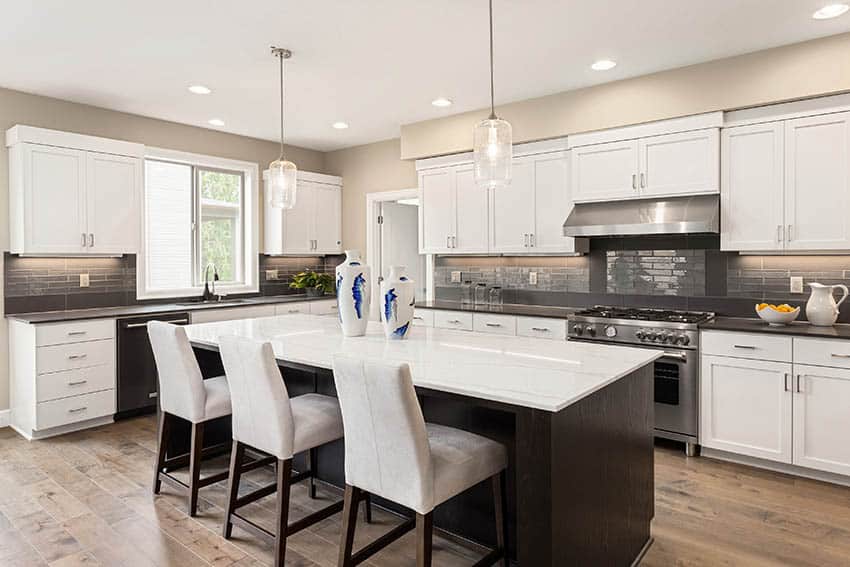
Shaker style cabinets are universally loved and remain to be one of the most popular kitchen cabinet styles in the market. But other than its clean aesthetics, what other attributes make it a worthy investment for your home?
Pros of Shaker Style Cabinets
Here are some of the advantages of these cabinets:
Sleek, uncluttered look. A perfect manifestation of the design philosophy “less is more”, these cabinets have an enduring utilitarian appeal, a minimalist aesthetic and a very clean look that can lend a big impact to a kitchen setting.
Timeless appeal. Known to be a “classic” cabinet design, the Shaker style is simply timeless and elegant. It will never go out of style even in the years to come. In addition, you can easily update its look to keep up with trends just by treating it with a fresh coat of paint or by changing the hardware.
Versatility. These products are compatible with most kitchen styles, hardware, and concepts — from traditional, transitional, contemporary and modern.
Offers design flexibility and gives you room to express yourself. Since these flat panel doors do not have any embellishments, they give you room to personalize your kitchen.
Depending on your taste and preferred design, you can either add bevelled or beaded edges to your doors. They also lend themselves to a wide range of finishes.
They also set a good foundation to experiment with the rest of the design of your kitchen. You can easily match it with a variety of flooring materials, countertops, backsplashes, and other design elements in the space.
Full of charm. The charming appeal of a Shaker cabinet can instantly make a home feel welcoming and homey. Its inviting charm makes it perfect for rustic interiors.
Less expensive than other kitchen cabinet styles. Because there is no ornamentation used in construction, these cost less compared to more detailed door designs.
Readily available in the market. A lot of cabinet manufacturers and suppliers have this style in stock and they can also be easily custom-made by a skilled professional.
Available in many wood species and in different finishes. They are typically constructed using best-quality solid woods which can be treated with different finishing materials.
Often found in frameless construction. As mentioned earlier, these styles are more commonly found in frameless construction. Frameless cabinets provide fuller access compared to framed cabinets.
Cons of Shaker Style Cabinets
Here are some of the disadvantages of Shaker style cabinets:
Harder to clean than slab style cabinets. Although considered to be low maintenance, cleaning Shaker cabinets is a little bit more difficult compared to slab or flat door panels because they may gather residue in the corners of the center panel.
However, they are easier to maintain compared to highly ornate cabinetry doors because of the absence of excessive details which might trap debris or grease residues.
Too classic for modern kitchens. The shaker style suits modern kitchen styles, however, some homeowners may find that slab doors are more suited for ultra modern and minimalist kitchen concepts.
Raised Panel Cabinet Door Pros And Cons
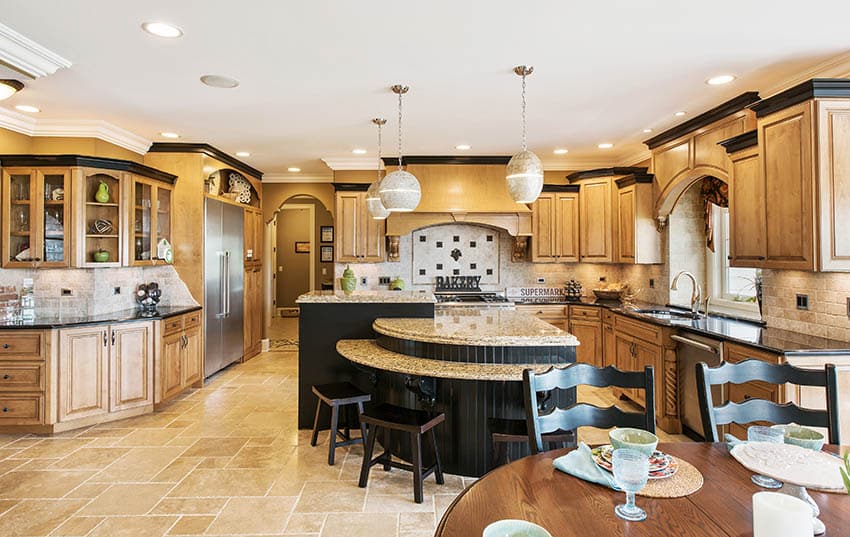
Raised panel cabinets are a consistent favorite in traditional-style homes. But other than its class and formal look, what other attributes make it a worthy investment for your home?
Pros of Raised Panel Cabinets
Here are some of the advantages of raised panel cabinets:
Traditional style. Raised panel cabinetry offers a traditional look with its formality and elegance.
The raised panel provides an additional dimension to the cabinet door design. The center panel which floats in the center of the frame creates more depth and gives kitchen cabinetry more character as compared to slab style and recessed style doors.
Many decorative options. You can introduce different decorations to your raised panels to make them more unique which can include decorative trims, bevelled edges, beading, glass, and metal inserts.
Rail and molding options available. In connection with a wide range of decorative options, you can choose from different rails and moldings to include in your raised panel door and drawer fronts.
Many wood species and finishes are available. Similar to Shaker, raised panels are typically constructed using best quality solid woods which can be treated with different finishing materials.
Readily available in the market. A lot of cabinet manufacturers and suppliers have these doors in stock and they can also be easily custom-made by a skilled professional.
Often found in framed construction. As mentioned earlier, raised panel cabinets are more commonly found in framed construction which makes the cabinet sturdier and gives it more strength.
Cons of Raised Panel Cabinets
Here are some of the disadvantages of raised panel cabinets:
More expensive than other cabinet door styles. Raised panel doors generally cost more than recessed or Shaker style and slab style doors.
Difficult to find in frameless construction. Raised panel doors are difficult to find in frameless construction because most cabinet makers make traditional-style cabinets in a framed method.
Differences in Cabinet Cost
Kitchen cabinets are priced in several ways and a lot of cost factors such as the materials used, finishing, boxed construction, and design contribute to their overall price. The cost of labor for building the cabinet door will greatly depend on the style used.
In most cases, raised panel doors tend to cost more than Shaker style cabinets. Typically, Shaker cabinets cost about $16 in labor fees, whereas raised panel doors cost approximately around $30 in labor fees.
For a 10 feet x 10 feet kitchen with all plywood cabinets finished in white paint, the raised panels also tend to cost more than Shaker style.
For the materials alone, it will cost around $2,706 to build Shaker style cabinets for a 10×10 kitchen, while raised panel doors would take roughly $3,392 to construct.
Installation cost for both types of cabinets cost an average of $2000, which would bring the total project cost to $4,706 for Shaker kitchen cabinetry and $5,392 for raised panel cabinetry.
What Is Best For A Kitchen Design, Shaker Or Raised Cabinets?
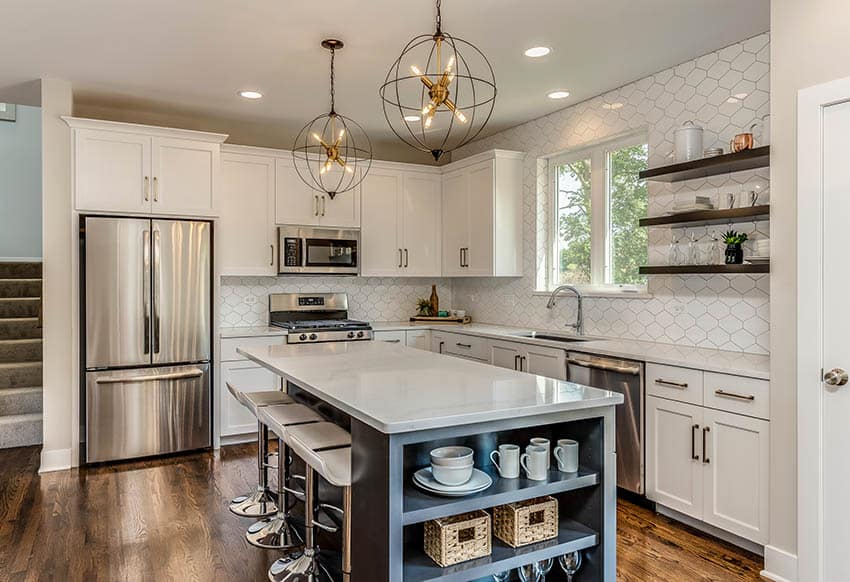
Since each of these cabinet door types conveys different styles, the answer to this question may vary. Deciding on which style is better between Shaker and raised panel cabinets will ultimately depend on the existing style of your kitchen and the look you envision for it.
To help you out in deciding which one is the best for a kitchen design, here are our recommendations based on different factors.
Best for Traditional homes and kitchens – Raised panel doors. This type of door leans traditional and has a more formal look.
Best for modern, contemporary and transitional styles – Shaker style doors. The straightforward design appeal of Shaker kitchen cabinets makes them perfect for more modern kitchen concepts, which lean towards a minimalist and clean aesthetic.
Most versatile – Shaker style doors. This type of cabinet door style can support a wide range of design concepts which makes them a popular go-to option for a lot of homeowners.
If you see yourself changing your kitchen style from time to time, Shaker is the perfect option because it will not look off whether you transition from rustic to contemporary or vice versa. Shaker cabinetry can also be easily updated if you want to shift from one look to another.
For more related designs, visit our gallery of white cabinetry here. Also don’t forget to tell us if you prefer shaker or raised cabinet panels the best in the comments.

